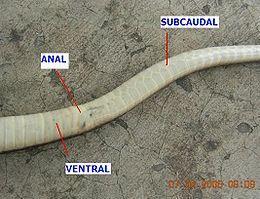How do you identify nonpoisonous snakes?
By don
Add your voice! Click below to answer. ThriftyFun is powered by your wisdom!
I have attached a picture on a nonpoisonous snake. Of course, it is not advised to try and tell when the snake is alive ha ha.
In the picture, where you see the scales interlock with eachother means it is nonpoisonous.
If the scales were to stay lined up the way they are above the anus, it is poisonous.
You can also squeeze the head of a dead snake on the sides of the eyes and if fangs pop out, it is more than likely venomous.
Although these ways are effective, always see a doctor regardless of whether or not the snake is poisonous. If you are bitten by a snake it is very important to remain as calm as possible. As your heart rate increases from the panic you are experiencing, the faster your blood (along with the venom) pump faster throughout your body.

Since you would have to first kill a snake to look under it, I suggest you look at head shape. Poisonous snakes usually have a wedge or spear shaped head and their pupils (which are easy to see as snakes have no eyelids) are up and down shaped like in a cat's eye. All snakes will bite when cornered to defend themselves. Some even have small teeth although they are non-poisonous. Getting a book with pictures of patterns of poisonous snakes in your area will help you to know which ones are beneficial and which ones to avoid or remove.
Killing non-poisonous, beneficial snakes is wasteful and cruel. Non-poisonous snakes keep the mice and rat population at a tolerable level and rodents are by far the more disease infested and destructive.
Learning you have killed a harmless snake is too late to save the snake. It could have made your yard a safer place for you and if you have them our children.
Names of the snake
In the United States, round pupils in the eyes are the best way. The only venomous snake in the US with round pupils is the Coral Snake, whose eyes are black so that the pupil is not visible anyway. Head shape is not a great rule....All pit vipers (Rattlesnakes/Copperheads/Cottonmouths) have the wide triangular heads but many nonvenomous snakes (Rat/Water/Hognose etc) will flatten their heads into the exact same shape when they feel threatened. The pupil rule is the best without flipping the snake over. In the USA, there are four basic types of venomous snake: Coral Snake (Red/yellow/black with red touching yellow - you probably know the rhyme - and a jet black head with wide yellow collar). Rattlesnakes (easy to identify because they usually have a visible rattle), Copperheads, and Cottonmouths (which are essentially large aquatic Copperheads).
Add your voice! Click below to answer. ThriftyFun is powered by your wisdom!